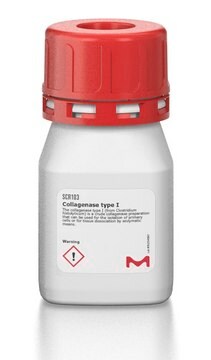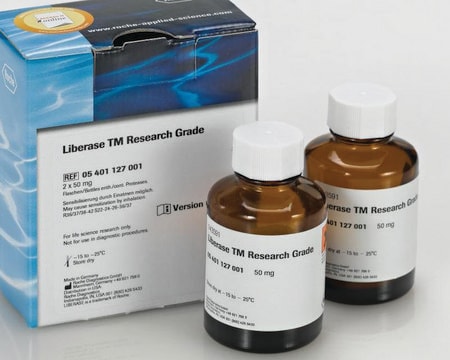Kluczowe dokumenty
COLLA-RO
Roche
Collagenase A
from Clostridium histolyticum
About This Item
Polecane produkty
pochodzenie biologiczne
Clostridium histolyticum
Poziom jakości
sterylność
non-sterile
Formularz
lyophilized
aktywność właściwa
>0.15 U/mg lyophilizate (Collagenase activity)
opakowanie
pkg of 100 mg (10103578001)
pkg of 2.5 g (11088793001)
pkg of 500 mg (10103586001)
producent / nazwa handlowa
Roche
stężenie
1 mg/mL (0.1%, w/v)
kolor
brown
optymalne pH
6.0-8.0
rozpuszczalność
water: soluble
przydatność
suitable for PCR
numer dostępu NCBI
numer dostępu UniProt
Zastosowanie
cell analysis
life science and biopharma
sample preparation
obecność zanieczyszczeń
Clostripain 9.489 U/mg
Proteases 6.067 U/mg (Azocoll )
Trypsin 0.144 U/mg (with BAEE)
temp. przechowywania
2-8°C
informacje o genach
Clostridium histolyticum ... COLA_1(1668506084)
Opis ogólny
Specyficzność
Enzyme activity:
Collagenase activity: >0.15U/mg (according to Wünsch) (+25°C, 4-phenyl-azobenzyl-oxycarbonyl-Pro-Leu-Gly-Pro-D-Arg as the substrate)
Contaminating enzyme activities: trypsin, clostripain, and neutral proteolytic activity
Collagenase A has a balanced ratio of enzyme activities.
Zastosowanie
- Disaggregation of many types of tissues (e.g., lung, heart, muscle, bone, adipose tissue, liver, kidney, cartilage, mammary gland, placentae, blood vessels, brain, tumors, umbilical cord)
- preparation of single-cell suspensions for the establishment of primary cell culture systems. Collagenase A is recommended when yield, viability, and functionality are important.
- preparation of cells from many types of tissue, such as hepatocytes, adipocytes, pancreatic islets, epithelial cells, muscle cells, endothelial cells, etc. However, the suitability of each lot of the enzyme for disruption of a particular tissue should be determined empirically.
Definicja jednostki
Lyophilizate, nonsterile
Frequently, collagenase activities are given in Mandl units (1 μmol leucine liberated from collagen in 5 hours at +37 °C).
Unfortunately, there is no consistent conversion factor between the two units of activity, since the Mandl unit depends, in part, on the concentration of contaminating proteases in the collagenase preparation, an indefinable variable. A purer collagenase preparation would actually give a lower specific activity in Mandl units than a crude preparation. Clostridium preparations typically give conversion factors of approximately 1:1800 (e.g., a particular lot of Clostridium collagenase contained approximately 0.15 Wünsch U/mg and 250 Mandl U/mg).
Uwaga dotycząca przygotowania
Inhibitors:
Collagenase inhibitors: EDTA, EGTA, Cys, His, DTT, 2-mercapto-ethanol
Collagenase is not inhibited by serum.
Clostripain inhibitors: TLCK
Trypsin inhibitors: aprotinin, trypsin inhibitor (egg white, soybean), serum
Working concentration: 0.5 to 2.5 mg/ml
Storage conditions (working solution): -15 to -25 °C
Roche recommends reconstituting only the amount of lyophilizate needed for immediate use. The reconstituted solution can be stored at -15 to -25 °C for up to one week. Avoid repeated freezing and thawing since activity decreases after reconstitution.
Rekonstytucja
Przechowywanie i stabilność
Inne uwagi
Hasło ostrzegawcze
Danger
Zwroty wskazujące rodzaj zagrożenia
Zwroty wskazujące środki ostrożności
Klasyfikacja zagrożeń
Eye Irrit. 2 - Resp. Sens. 1 - Skin Irrit. 2 - STOT SE 3
Organy docelowe
Respiratory system
Kod klasy składowania
11 - Combustible Solids
Klasa zagrożenia wodnego (WGK)
WGK 1
Temperatura zapłonu (°F)
does not flash
Temperatura zapłonu (°C)
does not flash
Wybierz jedną z najnowszych wersji:
Masz już ten produkt?
Dokumenty związane z niedawno zakupionymi produktami zostały zamieszczone w Bibliotece dokumentów.
Klienci oglądali również te produkty
Produkty
Enzyme Explorer Key Resource: Collagenase Guide.Collagenases, enzymes that break down the native collagen that holds animal tissues together, are made by a variety of microorganisms and by many different animal cells.
Powiązane treści
Kolagenazy, enzymy rozkładające natywny kolagen, który utrzymuje tkanki zwierzęce razem, są wytwarzane przez różne mikroorganizmy i wiele różnych komórek zwierzęcych.
Nasz zespół naukowców ma doświadczenie we wszystkich obszarach badań, w tym w naukach przyrodniczych, materiałoznawstwie, syntezie chemicznej, chromatografii, analityce i wielu innych dziedzinach.
Skontaktuj się z zespołem ds. pomocy technicznej









